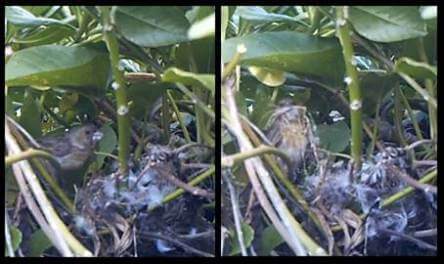Spying on the Birds
June 3 – 16, 2013
Megan Dalton
After Millerbird pairs have fledged their chicks and are through using their nests, we often will find nests on the ground in pieces as if something has torn them apart. Millerbirds have been known to “cannibalize” their old nests and reuse the nesting materials when building new structures.

Laysan Finch caught in the act of stealing nesting material from a recently fledged Millerbird nest. Photo credit: Megan Dalton.
However, we have also observed Laysan Finches tugging at them benignly without removing any material with their bills. Because we use a torn-apart nest as a clue to look for rebuilding pairs, we wanted to find out who exactly was doing the demolishing, so we set up a few motion-activated game cameras on some recently fledged nests.
After we found one nest thoroughly dismantled, we took down the camera and looked at the video footage. It was quite enjoyable to watch the birds' behavior, and they were seemingly unaffected by our presence in the field. For example, we saw that the banded fledgling that hatched in this nest actually spent quite a bit of time in and around the nest for over two weeks, poking around the structure itself, picking at the rootlets and blades of grass, even sitting in the nest as an adult incubating eggs would!
We also solved the mystery of the nest destruction: Besides the gentle probing of the Millerbird fledgling, there were several giant bill-fulls of nesting material taken not-so-benignly by a female Laysan Finch. But the largest amount of dismantling came three weeks later from the original Millerbird pair themselves who, once they decided that it was time to build a new nest, went full steam ahead in completely tearing apart the old one, taking the materials to an as-yet unknown location and leaving very few leftovers. The young fledgling, of course, had to find a new hangout.
Nature Sighting of the Week
The number of migratory shorebirds on Laysan has dropped dramatically as the majority of them has departed to fly thousands of miles north to their breeding grounds. The Wandering Tattler is one such bird that, after spending around eight months in their wintering grounds on islands in the south-central Pacific or on the coasts of North and South America, makes the long-distance trek—12,000 kilometers or more—to the tundra in Alaska and the Yukon.
The tattlers will waste no time in beginning their breeding activities and, after raising a typical brood of four, will then migrate back beginning in July. The juveniles follow in the fall. We are already missing their 'ulili” call, which is their Hawaiian name, and look forward to their return.
 Megan Dalton is a Millerbird
Megan Dalton is a Millerbird
monitoring biologist on Laysan.



















































